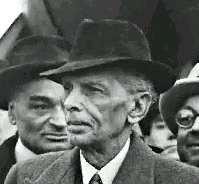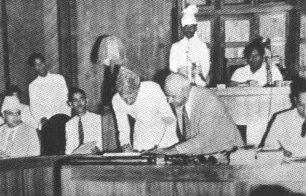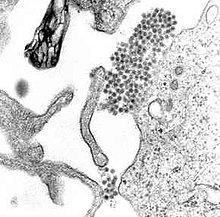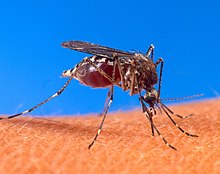The economy of the United States is the world's largest national economy. Its nominal GDP was estimated to be nearly $14.7 trillion in 2010,[1] approximately a quarter of nominal global GDP.[15][16] Its GDP at purchasing power parity was also the largest in the world, approximately a fifth of global GDP at purchasing power parity.[15] The U.S. economy also maintains a very high level of output per capita. In 2010, it was estimated to have a per capita GDP (PPP) of $47,284, the 7th highest in the world. The U.S is the largest trading nation in the world. Its three largest trading partners as of 2010 are Canada, China and Mexico.
Historically, the U.S. economy has maintained a stable overall GDP growth rate, a low unemployment rate, and high levels of research and capital investment funded by both national and, because of decreasing saving rates, increasingly by foreign investors. It has been the world's largest national economy since the 1870s[17][18] and remains the world's largest manufacturer, representing 19% of the world's manufacturing output. In 2009, consumer spending, coupled with government health care spending constituted 70% of the American economy.[19] About 30% of the entire world's millionaire population reside in the United States (in 2009).[20] Furthermore, 34% of the world's billionaires are American (in 2011).[21][22] The US is also home to the world's largest stock exchange, the New York Stock Exchange. It also boasts the world's largest gold reserves and the world's largest gold depository, the New York Federal Reserve Bank. The United States is also home to 139 of the world's 500 largest companies, which is almost twice that of any other country.[23] A large contributor to the country's success has also been a very strong and stable currency. The US dollar holds about 60% of world reserves, as compared to its top competitor, the euro, which controls about 24%.
Since the 1960s, the United States economy absorbed savings from the rest of the world. The phenomenon is subject to discussion among economists. The US is by far the most heavily invested-into country in the world, with foreign investments made in the US measuring almost $2.4 trillion, which is more than twice that of any other country.[24] The US is also by far the largest investor in the world, with US investments in foreign countries totaling over $3.3 trillion, which is almost twice that of any other country.[25] Like other developed countries, the United States faces retiring baby boomers who have already begun withdrawing money from Social Security; however, the American population is young and growing when compared to Europe or Japan. The United States public debt is in excess of $14 trillion and continues to grow at a rate of about $5.48 billion each day by direct calculation between December 31, 2010 and July 31, 2011.[26][27] Total public and private debt was $50.2 trillion at the end of the first quarter of 2010, or 3.5 times GDP.[28] Domestic financial assets totaled $131 trillion and domestic financial liabilities totaled $106 trillion.[29] Due in part to the amount of both public and private investment, the economy of the United States is regarded as a type of mixed economy.
Rank 1st (nominal) / 1st (PPP)
Currency United States Dollar (USD)
Fiscal year October 1 – September 30
Statistics
GDP $14.527 trillion (2010)[1] (1st, nominal and PPP)
GDP growth 3.0% (2010)[1]
GDP per capita $46,844 (2010)[2] (17th, nominal; 6th, PPP)
GDP by sector agriculture: (1.2%), industry: (21.9%), services: (76.9%) (2009 est.)
Inflation (CPI) 2.1% (February 2011)[3]
Population
below poverty line 15.1% (2010)[4]
Gini index 45 (List of countries)
Labor force 154.5 million (includes unemployed) (2009 est.)
Labor force
by occupation
farming, forestry, and fishing: 0.7% manufacturing, extraction, transportation, and crafts: 20.3% managerial, professional, and technical: 37.3% sales and office: 24.2% other services: 17.6%
note: figures exclude the unemployed (2009)
Unemployment 9.2% (June 2011)
Main industries petroleum, steel, motor vehicles, aerospace, telecommunications, chemicals, creative industries, electronics, food processing, consumer goods, lumber, mining, defense, biomedical research and health care services, computers and robotics
Ease of Doing Business Rank 5th[5]
External
Exports $1.280 trillion f.o.b (2010)[1]
Export goods agricultural products (soybeans, fruit, corn) 9.2%, industrial supplies (organic chemicals) 26.8%, capital goods (transistors, aircraft, motor vehicle parts, computers, telecommunications equipment) 49.0%, consumer goods (automobiles, medicines) 15.0% (2009)
Main export partners Canada, 13.2%; Mexico, 8.3%; China, 4.3%; Japan, 3.3%. (2009)[6]
Imports $1.948 trillion c.i.f. (2010)[1]
Import goods agricultural products 4.9%, industrial supplies 32.9% (crude oil 8.2%), capital goods 30.4% (computers, telecommunications equipment, motor vehicle parts, office machines, electric power machinery), consumer goods 31.8% (automobiles, clothing, medicines, furniture, toys) (2009)
Main import partners China, 15.4%; Canada, 11.6%; Mexico, 9.1%; Japan, 4.9%; Germany, 3.7%. (2009)[6]
FDI stock $2.398 trillion (31 December 2009 est.)
Gross external debt $14.39 trillion (30 Sept 2010)[7]
Public finances
Public debt $14.72 trillion (Sep 2011)[8] 98% of GDP
Revenues $2.162 trillion (2010)[9]
Expenses $3.456 trillion (2010)[9]
Economic aid ODA $19 billion, 0.2% of GDP (2004)[10]
Credit rating
Standard & Poor's:[11]
AA+ (Domestic)
AA+ (Foreign)
AAA (T&C Assessment)
Outlook: Negative[12]
Moody's:[12]
AAA
Outlook: Negative[13]
Fitch:[12]
AAA
Outlook: Stable
Foreign reserves US$140.607 billion (May 2011)[14]
Main data source: CIA World Fact Book
All values, unless otherwise stated, are in US dollars
The American labor market has attracted immigrants from all over the world and in 2009 ranked 16th in terms of net migration rate. The United States is ranked fourth, down from first in 2008-2009 due to the economic crisis, in the Global Competitiveness Report.[30] The country is one of the world's largest and most influential financial markets, home to major stock and commodities exchanges like NASDAQ, NYSE, AMEX, CME, and PHLX.












 In 1940 the Muslim League formally endorsed the partitioning of British India and the creation of Pakistan as a separate Muslim state. During pre-independence talks in 1946, therefore, the British government found that the stand of the Muslim League on separation and that of the Congress on the territorial unity of India were irreconcilable. The British then decided on partition and on August 15, 1947, transferred power dividedly to India and Pakistan. The latter, however, came into existence in two parts: West Pakistan, as Pakistan stands today, and East Pakistan, now known as Bangladesh. The two were separated by 1,600 km (1,000 mi) of Indian territory
In 1940 the Muslim League formally endorsed the partitioning of British India and the creation of Pakistan as a separate Muslim state. During pre-independence talks in 1946, therefore, the British government found that the stand of the Muslim League on separation and that of the Congress on the territorial unity of India were irreconcilable. The British then decided on partition and on August 15, 1947, transferred power dividedly to India and Pakistan. The latter, however, came into existence in two parts: West Pakistan, as Pakistan stands today, and East Pakistan, now known as Bangladesh. The two were separated by 1,600 km (1,000 mi) of Indian territory The demographic shift was accompanied by considerable inter-ethnic violence, including massacres, that reinforced bitterness between the two countries. This bitterness was further intensified by disputes over the accession of the former native states of India to either country. Nearly all of these 562 widely scattered polities had joined either India or Pakistan; the princes of Hyderabad, Junagadh, and Kashmir, however, had chosen to join neither country. On August 15, 1947, these three states became technically independent, but when the Muslim ruler of Junagadh, with its predominantly Hindu population, joined Pakistan a month later, India annexed his territory. Hyderabad's Muslim prince, ruling over a mostly Hindu population, tried to postpone any decision indefinitely, but in September 1948 India also settled that issue by pre-emptive annexation. The Hindu ruler of Jammu and Kashmir, whose subjects were 85 per cent Muslim, decided to join India. Pakistan, however,
The demographic shift was accompanied by considerable inter-ethnic violence, including massacres, that reinforced bitterness between the two countries. This bitterness was further intensified by disputes over the accession of the former native states of India to either country. Nearly all of these 562 widely scattered polities had joined either India or Pakistan; the princes of Hyderabad, Junagadh, and Kashmir, however, had chosen to join neither country. On August 15, 1947, these three states became technically independent, but when the Muslim ruler of Junagadh, with its predominantly Hindu population, joined Pakistan a month later, India annexed his territory. Hyderabad's Muslim prince, ruling over a mostly Hindu population, tried to postpone any decision indefinitely, but in September 1948 India also settled that issue by pre-emptive annexation. The Hindu ruler of Jammu and Kashmir, whose subjects were 85 per cent Muslim, decided to join India. Pakistan, however, 

 In some people, the disease proceeds to a critical phase, which follows the resolution of the high fever and typically lasts one to two days.[8] During this phase there may be significant fluid accumulation in the chest and abdominal cavity due to increased capillary permeability and leakage. This leads to depletion of fluid from the circulation and decreased blood supply to vital organs.[8] During this phase, organ dysfunction and severe bleeding, typically from the gastrointestinal tract, may occur.[5][8] Shock (dengue shock syndrome) and hemorrhage (dengue hemorrhagic fever) occur in less than 5% of all cases of dengue,[5] however those who have previously been infected with other serotypes of dengue virus ("secondary infection") are at an increased risk.[5][12]
In some people, the disease proceeds to a critical phase, which follows the resolution of the high fever and typically lasts one to two days.[8] During this phase there may be significant fluid accumulation in the chest and abdominal cavity due to increased capillary permeability and leakage. This leads to depletion of fluid from the circulation and decreased blood supply to vital organs.[8] During this phase, organ dysfunction and severe bleeding, typically from the gastrointestinal tract, may occur.[5][8] Shock (dengue shock syndrome) and hemorrhage (dengue hemorrhagic fever) occur in less than 5% of all cases of dengue,[5] however those who have previously been infected with other serotypes of dengue virus ("secondary infection") are at an increased risk.[5][12]







 Free, Gift, Downloads, Games & Mores... designed and coded by EZwpthemes | Bloggerized by FalconHive.
Free, Gift, Downloads, Games & Mores... designed and coded by EZwpthemes | Bloggerized by FalconHive.